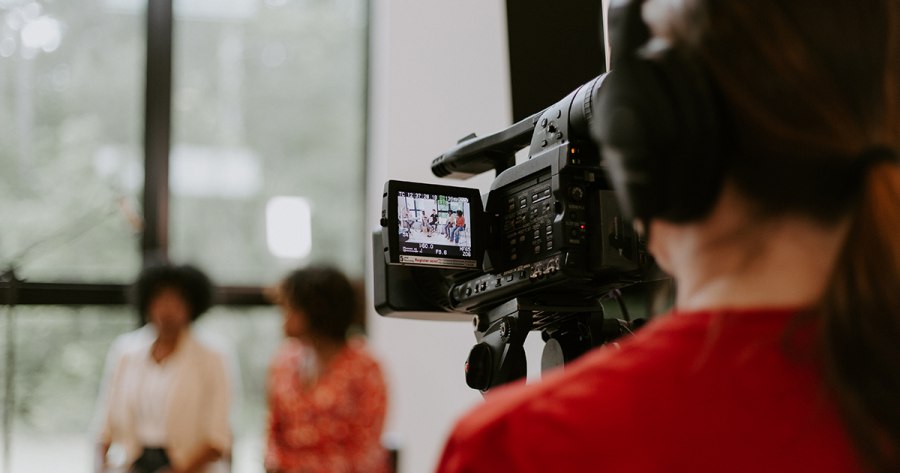Are you an AV or event production company that recently considered investing in virtual event production but not sure if it was right for you?
It’s no secret that the COVID-19 pandemic impacted the way the event industry does business. As a software provider for AV and live event suppliers, we’ve experienced firsthand the effects of Covid-19 on our industry.
As we slowly transition into the new normal, it is important that we keep in mind the lessons 2020 taught us and why it’s important now more than ever to stay connected with our customers.
Instead of canceling or continuously postponing events, you should take this time to reflect, research, and prepare your business for the future of the event industry.
Today, we caught up with Olivia Breene, head of Business Development at AVCOM, a pioneer in the live events industry, to give us a deeper look at the best practices AV and event companies can follow to make their virtual events a success.
In this guide, you will discover what virtual event production is, the best practices you should follow when producing virtual events, potential challenges you might face, and how you can address them.
I. An introduction to virtual events
II. Things you should know about virtual event production
III. Potential challenges and how to address them
IV. The advantages and drawbacks of hosting virtual events
VI. Closing recommendations
I. An introduction to virtual events
1. What are virtual events?
Virtual events are online events where people gather to share ideas, enjoy a shared experience and connect with one another over the internet rather than in person.
Today, any type of event that includes an online element and an audience engagement can be classified as a virtual event.
Here are some of the most common types of virtual events:
- Webinars
- Virtual conferences
- Virtual tradeshows and exhibitions
- Hybrid events
2. Why are virtual events popular today?
Last year, virtual events were valued at close to $78 billion and were expected to grow at 23.2 percent annually from 2020 to 2027.
Although virtual events have been around for a while now, the Covid-19 pandemic and the health restrictions that were in place in the past year have only accelerated that growth.
Olivia Breene from AVCOM told us that “Virtual events have always been talked about over the past 5 years but no one wanted to move away from live events because it was too much of a change.”
She also highlighted that “Now we’ve been pushed into this all-new era of innovation that isn't going to go away because virtual events have created this whole new world of inclusivity, diversity, and accessibility. Everything that we thought would never go online is now going online.”
Today, AVCOM covers all types of virtual events:
- from small meetings that you would have with Microsoft Teams,
- up to 6-day global conferences that are reaching 5 continents and over 10,000 attendees.

II. Things you should know about virtual event production
1. What is virtual event production?
Virtual event production is the process of producing a virtual event from start to finish and really looking at its technical production.
Technical production is the process of setting up and managing every aspect of a virtual event’s technical setup and understanding how to create an engaging experience for virtual attendees.
Technical producers are responsible for managing technical production and are closely involved with the creative process of producing the event. They contribute by making creative plans and translating them into technical solutions that reflect the artistic vision of the client.
2. What are the different steps of virtual event production?
Just like live events, virtual events consists of 3 main phases:
- pre-production
- event production
- and post-production.
However, Olivia revealed that the pre-production phase for virtual events is now different from what they were used to for live events due to the importance of testing and programming.
According to her: “There’s an awful lot of pre-production that has to go in any virtual event, this would not have been part of what the AV delivery would have included previously.
Previously, you would have been dealing with clients on the 1- up of the event, then you would arrive on the day before the event, set up and test the equipment then go straight into the live event. Whereas now, in the virtual world, with a 100% remote delivery, there’s a lot of testing and programming done remotely.”
Additionally, she explained the virtual event production process in 3 steps:
- The discovery meeting
- The Sales and education cycle
- Creative and technical
Step 1: The discovery meeting
The first step is having a discovery meeting with the client to understand what he/she wants to achieve and then very clearly setting his/her expectations.
It’s important to mention that delivering a virtual event is similar to delivering a high-quality TV production because everything during the event must be monitored second-by-second.
Once that you’ve understood the type of end deliverable the client wants, you will have to educate them on how they can achieve that.
Step 2: The Sales & Education cycle
The next step is to look at budgets, deliverables, and how to achieve the result that the client wants.
Once you’ve done your research, made your plans, and agreed on the plan and process with the client, you can bring in the technical team.
Step 3: Creative and technical
During this step, technical producers work directly with clients and deal with everything that has to do with agendas, pre-recorded videos, attendee experience, to have an understanding of what should be the requirements of the event.
In their technical running orders, they need to know what is happening every single second. The technical producer’s job is important because he/she has to make sure that everything is going according to the schedule.

III. Potential challenges and how to address them
1. Planning
Generally, AV companies are introduced at the very end of the event planning process, once people have decided on their venue and entertainment.
However, for virtual events, they are introduced at a much earlier stage.
Olivia mentioned that AVCOM was used to coming into events when everything was nearly planned. They came in and explained how they were going to execute that plan.
Whereas now, they are being brought in at the very beginning of the planning stage.
2. Processes
Since technical producers now spend most of their time in the planning and pre-production phase with the client, AVCOM had to change some of the processes that they were used to using for live events.
Normally, their account managers would see the event right up to event day, be on-site, and introduce the technical producer to the client.
Whereas now, the account manager helicopter views the event production and checks in with the client from time to time, and the technical producer looks after the client from stage 3 right up to the day of the event.
Olivia also highlighted that “It's important to have really good processes and be able to constantly adapt them. After every event, you should do a post-production meeting to analyze the performance of the event and identify what needs to be adapted in your processes for future events.”
3. Educating the customer
It’s an educational process to explain to clients that having a virtual event costs just as much as having an in-person event.
What happens is that they usually think that going online is cheaper, when in reality it’s not. You’re trying to create a TV production quality event on a budget that you would have for a more simplistic event.
It is important that you educate the client on the requirements of the team and the requirements of the pre-planning process.
4. Research & Development
AVCOM have been in business for 40 years and has been live streaming for approximately 20 years now. However, their idea of a virtual space was having one camera at the back of an event and live streaming it.
When the Covid-19 pandemic hit and business slowed down, AVCOM used that time to work on Research & Development, observe what’s happening in the industry and come up with ideas on how they can utilize what they have available to provide a service for their client.
They learned very quickly how important content and content creation is for virtual events and how to utilize their graphics department and videography department to make really engaging events.
They also realized that to create an event online you need to have a platform. As a result, they hired new software developers and created partnerships with different companies to help them with this.
The recent pandemic has shown that everyone is stronger together, which is why it was very important for them to partner with the right people.
During the past year, and even today, AVCOM has been constantly learning more about the changes in the industry since it has been evolving at such a rapid pace.
5. Pricing
When it comes to pricing, it’s important that you understand what your value proposition is and how you are different from your competitors.
Then you must bring your client on that journey so they understand it too.
When quoting virtual events, it’s about what the overall experience is going to be and who is on the team. The most important resource that you have is your team, you should make sure that you are charging enough for them.
Since we’re in such volatile times, you must constantly review and adapt your pricing model. AVCOM implemented a dynamic pricing model, so their prices go up and down based on what is happening in the industry and what their competitors are doing.
They also had to look at more entry-level production options for clients. So if clients are only looking to do a one-hour webinar, for example, they can also support and manage that with an entry-level price point.

IV. The advantages and drawbacks of hosting virtual events
1. Advantages
Accessibility
The biggest opportunity that has come out of virtual events is accessibility. There is no traveling required to attend virtual events which means that now you can deliver events from anywhere in the world and connect with larger audiences.
Over the past year, virtual events have allowed many businesses and brands around the world to connect with much larger audiences, different types of cultures, and different environments that were not available to them previously.
Marketing data
Virtual events are mainly hosted on virtual event platforms that provide a rich source of marketing data for event organizers and sponsors.
Virtual attendees leave a digital footprint on these platforms, so all of their activities can be tracked and evaluated.
Analytics
Analytics show how attendees interact with your event content and the topics that resonate with them. It also shows which speakers were able to engage the attendees the most. Metrics like speaker profile views, session registration, and content downloads can provide the needed insight to plan content and select speakers for future events.
2. Drawbacks
Human connection
One of the biggest advantages of live events is the human interactions that it offers.
This type of human interaction can’t be replicated online and there’s currently no technology available that can entirely replace it.
Networking
Another drawback of virtual events is the networking that takes place.
Sometimes, the most effective networking is done out-of-session, at after-hours social events. While this is more difficult online, it is still possible to create spaces for discussion through live chat and virtual lounges.
Virtual events also offer opportunities for virtual attendees to connect with people they may not have had the opportunity to connect with before.
Engaging attendees can be more difficult:
When live streaming virtual events it can be difficult to keep attendees engaged if they are attending from home, they might have other things competing for their attention.
To make virtual events engaging, Olivia mentioned that AVCOM usually recommends using the 8x8 method. With this method, events consist of 8 8-minute segments.
No segment is longer than 8 minutes because generally, people’s ability to engage with what is happening on the screen fades off after 8 minutes.
Online content needs to be designed to accommodate natural attention spans. It also needs to offer enough interesting content to make sure that virtual attendees come back after taking breaks.
Closing recommendations
Sometimes the advantages of going online far outweigh the disadvantages. That’s why Olivia believes that hybrid events are going to be hugely important moving forward.
However, you should remember that virtual events are not a replacement for other types of events, instead, they are a new type of offer that you can add to enhance your entire program.
When planning virtual events, it’s also important that you use the right tools.
Today, the different teams at AVCOM use Rentman to plan all of their virtual events.
Olivia revealed that the sales team at AVCOM uses Rentman to build and plan each project. As head of Business Development, she uses Rentman to have a full overview of projects and keep track of the availability of teams for virtual events.
She also uses Rentman to forecast areas of opportunity for the business and identify red dates where teams and equipment are at full capacity.
Since Rentman provides a full overview of what is planned for the month ahead in one click, she can then use this information to plan marketing campaigns and social media content.
Would you like to experience how Rentman can help you manage your virtual events more efficiently? Start your free 30-day trial today!
If you are interested in hosting a virtual event, please feel free to reach out to Olivia at olivia.breene@avcom.ie.

